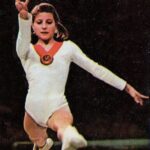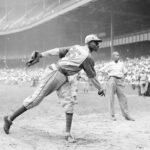They are The Topps! 10 Iconic Football Cards
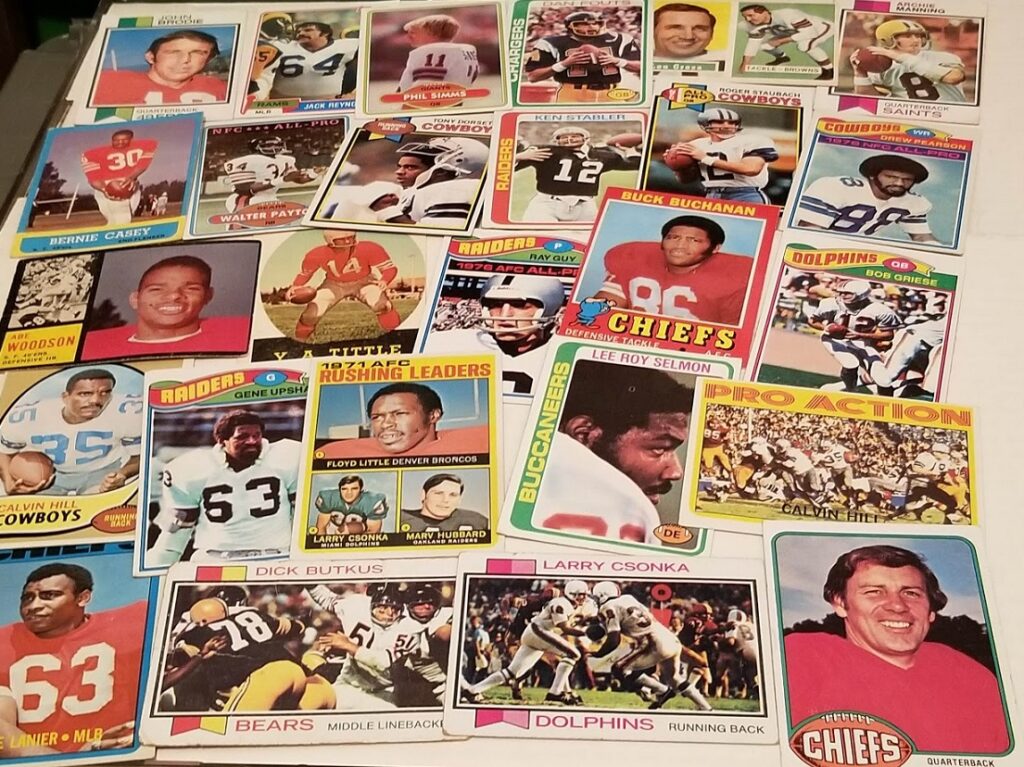
In this time when we are all spending time at home, I have spent some of my time looking at some of my old sports cards and memorabilia. As part of a new series about sports cards, I am starting by sharing 10 of my favorite football cards. Not necessarily my favorite players, but 10 cards that I think are cool, different or just unusual.
With a few exceptions, Topps Football Cards for their first couple decades were largely static pictures of players either as staged pictures or later pictures of players standing or sitting on the sidelines.
In 1972 the Sunoco Football Stamps came out with most of the pictures being awesome game action photos that were far better than anything Topps had ever produced on a football card. Beginning in 1972 with their own special action cards and then the next year in the regular series, Topps started trying to have more game action photos, though the results were a bit mixed.
Though cards produced in the last 30 years have gotten significantly better in terms of action pictures, my heart belongs to the Topps Football Cards from the 1950s through the 1970s, so all of my picks for this article are from that time period.
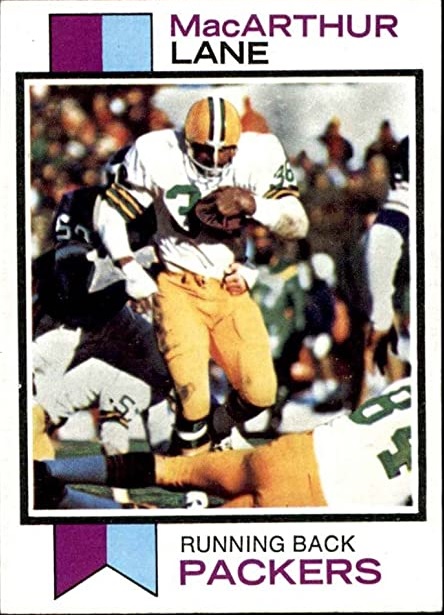
1973 MaCarthur Lane – Green Bay Packers
The 1973 Topps football card set was one of the first where Topps successfully incorporated action photos into the regular set as player cards. They were slightly hindered by the fact they could not show the team logos, so there are some cards with some interested color patches to block out the logos, but some of the action shots are pretty good.
My favorite of the action shots is the card of Green Bay Packers running back Macarthur Lane because it looks like he is holding a flat football. Though likely an illusion created by his hand, I remember seeing this card as a kid and thinking he was so strong that he flattened the football.
Lane spent 11 seasons in the NFL, playing for the Cardinals, Packers and Chiefs. His most productive season was with St. Louis in 1970 when he rushed for 977 yards and 11 touchdowns. Traded to the Packers before the 1972 season, he teamed with John Brockington to help the Packers reach the playoffs for the first time since 1967. In 1976, Lane led the AFC with 66 receptions while playing for the Chiefs.
He finished his career with 4,656 career rushing yards and 2,786 yards receiving. Lane passed away in 2019.
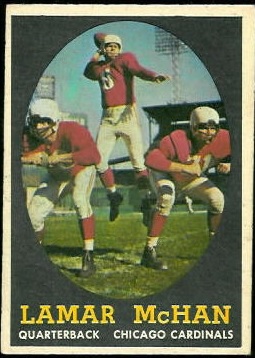
1958 – Lamar McHan – Chicago Cardinals
Though he spent 10 seasons as a quarterback in the NFL, there is a pretty good chance that you have never heard of Lamar McHan. However, from the first time I ever saw his 1958 Topps card, it has been among my favorites.
In 1958 Topps seemed to try and have some type of action within many of their cards, though they were clearly all staged as part of photo shoots. There is the iconic photo of Jim Brown running with the ball, but without his helmet.
Lamar McHan is wearing his helmet, as is two of his linemen who are in front of him in the photo. McHan is shown making a jump pass in an empty stadium. While in some respects a bit corny, to me this card is among the best at depicting an era in the NFL where the league was still somewhat innocent, but also starting to recognize its attraction and potential for becoming a fan favorite.
McHan was the primary starting quarterback for the Chicago Cardinals from 1954-1958. As a rookie, he led the league with 22 pass interceptions as the Cardinals went 1-10-1. He did, however, lead them to a 7-5 record just two years later.
Interestingly, after losing the starting job with the Cardinals, he moved to Green Bay in 1959, which was also the first season for Vince Lombardi as the head coach of the Packers. In 1959 McHan actually started more games for the Packers than Bart Starr, but was just 3-4 as the starter. The next season, McHan replaced Starr as the starter after Green Bay lost the season opener and went 4-0 as a starter. However, Starr eventually returned to the lineup and McHan saw little action late in the year as the Packers reached the NFL Championship Game.
McHan spent the next two seasons seeing little action as the backup to Johnny Unitas in Baltimore before completing his career with the San Francisco 49ers in 1963. He passed away in 1998.
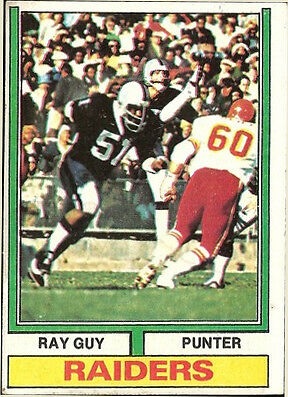
1974 Ray Guy – Oakland Raiders
It was a big deal in the NFL in 1973 when the Oakland Raiders used a first round pick to draft punter Ray Guy from Southern Mississippi. At 6-foot-3, Guy had long legs and when he extended his leg upward when kicking it looked unlike the style of any previous kicker.
As a rookie in 1973, Guy averaged 45.3 yards per punt and really started to usher in the era when punt hang time was worth tracking.
In my opinion, his 1974 rookie card is one of the better action cards of that era. It shows Guy extending his leg and punting the ball in the background while teammate Joe Carroll is shown starting to run down for the punt. Given that Carroll played only 22 games in two seasons with the Raiders, I expect this is the only Topps card in which the former 11th round pick appears.
Of course, Guy would go on to appear in many additional football cards throughout the remainder of his career. He led the NFL in punting average three times and retired with a career average of 42.4 yards per kick while playing on three Super Bowl winning teams.
In 2014, Guy became the first pure punter named to the Pro Football Hall of Fame.
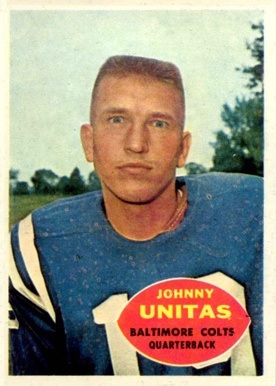
1960 Johnny Unitas – Baltimore Colts
I am generally not a fan of posed “head shot” type football cards and I suppose the 1960 Johnny Unitas Topps card is a great example of what doesn’t work about those type of cards.
By the end of the 1959 season, Johnny Unitas had led the Baltimore Colts to a pair of NFL Championships and was growing his legacy as the greatest quarterback of his era. However, his expression on his 1960 Topps card is anything but that of a fierce field general. His almost blank, toothless, expression makes it clear he doesn’t want to be there and maybe isn’t even sure what he is supposed to be doing.
Maybe the Colts opponents saw the card and were no longer intimidated by Unitas because the Colts went from back-to-back league champions to posting only a 6-6 mark in 1960. In fact, it would not be until 1964 that the Colts again made the post season.
Despite his unfortunate 1960 card, Unitas went on to cement his legacy as one of the greatest quarterbacks in NFL history. He retired as the NFL all-time leader with 40,239 career passing yards and 290 touchdown passes. Unitas later was a football analyst and local icon in Baltimore before passing away in 2002.
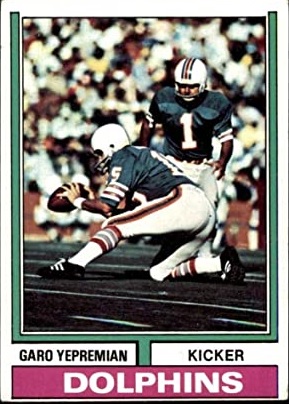
1974 Garo Yapremian – Miami Dolphins
The 1974 Garo Yapremian Topps football card is one of my favorites for a number of reasons.
First, I think it is a cool action shot of Earl Morrall placing down the hold for Yapremian to kick. Second, having the all-white helmet without the Dolphins logo is another example of Topps inability at the time to display team logos.
However, the biggest reason I like this card is that it reminds me of another play in which Morrall and Yapremian were part of during Super Bowl VII. In that game against the Washington Redskins, the Dolphins were winning 14-0 and looked like they would put the punctuation on a 17-0 season by taking a 17-0 lead late in the game. However, Yapremian’s kick was blocked and he attempted an ill-fated pass that was eventually grabbed by Mike Bass and taken for a score.
Though the picture on this card is from a different game, it still points me back to that memory.
Yapremian, who had begun his career with the Detroit Lions, spent nine years as a member of the Miami Dolphins before finishing his career with a season in New Orleans and two in Tampa.
He completed his career with 1074 career points. Yapremian passed away in 2015.
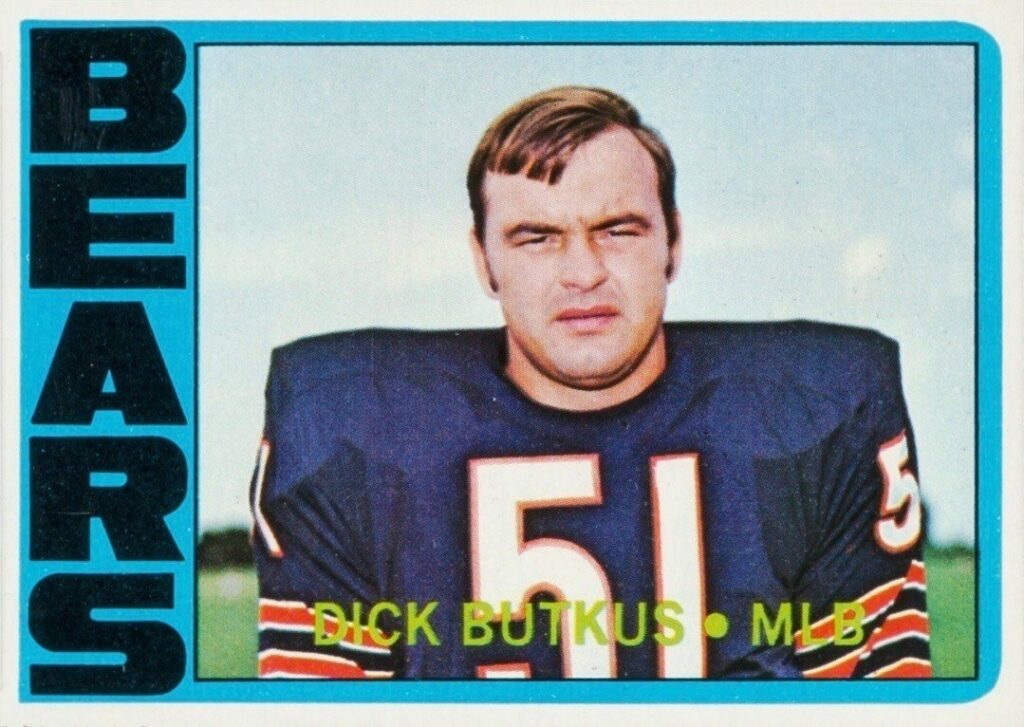
1972 & 1973 Dick Butkus – Chicago Bears
I am including both the 1972 and 1973 Dick Butkus football cards on this list because in their own way, each card depicts an interesting side of one of the greatest defensive players of all-time.
Much like the 1960 Unitas card, the 1972 Butkus picture is a straight-on half body and head shot. What is striking is that a player known as one of the most ferocious in the NFL of his era is shown with a clean-shaven almost baby-like face. He looks almost too nice to be the big, bad player that his reputation has created.
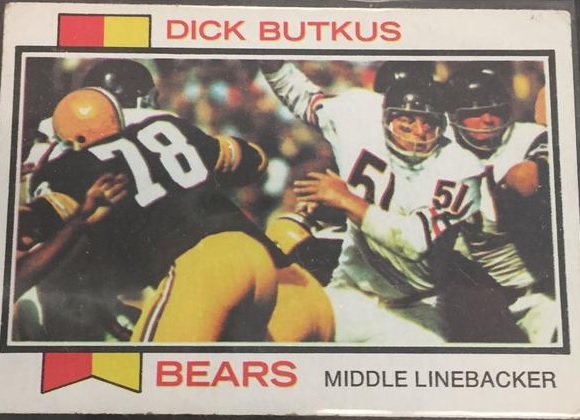
In contrast, the 1973 card is a game-action shot in which you can see more of the intensity of Butkus as a great middle linebacker. With him squarely depicted in the middle of the horizontal picture, it is one of the better action shots from that early attempt by Topps to show game-action.
Unfortunately, injuries cut short the career of Butkus as he retired after the 1973 season. He did have a 1974 card, but it is another posed photo, this time with Butkus sporting a mustache.
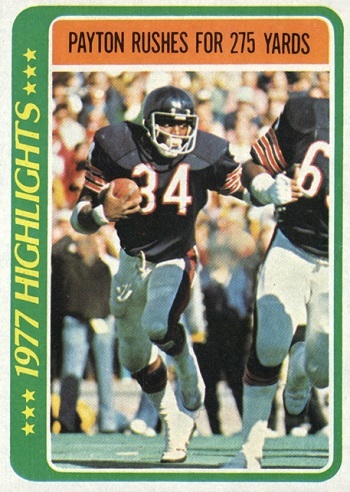
1978 Walter Payton – Record Breaker
After moving in the direction of game action photos for many cards from 1973-1977, in 1978 Topps seemed to move away from having a lot of actual game action photos. In fact, most of the photos seem to be of players sitting on the bench or standing around during games.
The best action photos from the 1978 set are actually from the record breaker cards. There is a good action shot of O.J. Simpson against the Colts and another of Walter Payton that celebrates his record-setting 275 yard rushing performance against the Vikings.
While it appears that the action photo is from a different game, it is a great shot of Payton following his blocker around the right side.
Payton led the NFL with a career-high 1,852 yards (in just 14 games) in 1977 and went on to retire as the NFL career leader with 16,726 yards rushing. He passed away in 1999.
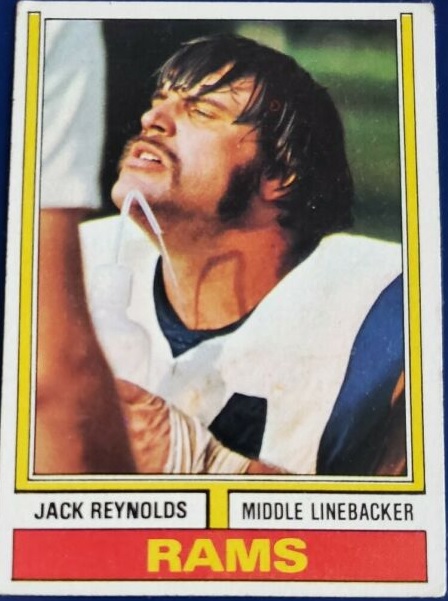
1974 Jack Reynolds – Los Angeles Rams
Longtime NFL linebacker Jack “Hacksaw” Reynolds was known for being focused and tough. His 1974 Topps card is one of my favorites because it is very clear that he is focused on anything but getting water into his mouth.
The picture depicts Reynolds on the sidelines with a water bottle that is clearly pouring water. However, instead of trying to get the water into his mouth, Reynolds seems oblivious to the fact that the water is going onto his uniform. The photo even includes a neat shadow that shows the water and bottle.
Later in his career, while playing for the San Francisco 49ers, Reynolds was famous for being dressed head-to-toe in his uniform when he went to the team meal prior to a Super Bowl. Clearly, Reynolds had a great ability to tune out other factors and focus only on the game.
He helped the Los Angeles Rams reach the Super Bowl in 1979 and then played on a pair of Super Bowl Championship teams in San Francisco.
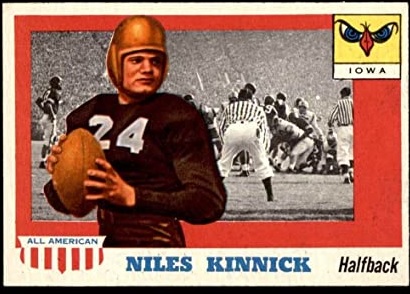
1955 Nile Kinnick – All-American card
Though technically not pro football cards, the 1955 Topps All-American cards are among my favorites. The cards include many great college football players with a color image in the fore-ground and then a black and white action shot in the background.
The series includes many of the great college football icons of the first half century of college football. It includes Knute Rockne, Jim Thorpe, the Four Horsemen, Red Grange and many more.
However, my favorite card of the series is of a player who unfortunately never got a chance to show his skills in the NFL.
Nile Kinnick (mistakenly listed as Niles Kinnick on his card), was the 1939 Heisman Trophy winner from the University of Iowa. After graduating, he appeared in the 1940 College All-Star Game between the college All-Stars and the champion Green Bay Packers. Kinnick scored two touchdowns and kicked four extra points in the game.
He was drafted into the NFL by the Brooklyn Dodgers, but instead of going to the NFL, he chose to attend law school at the University of Iowa. The grandson of a former Governor, he seemed to have all the makings of a future political leader.
After one year in law school, he joined the Navy reserves and reported for induction into the Navy three days before Pearl Harbor. He was training to be a fighter pilot when he was killed during a training mission in 1943.
Kinnick was inducted into the College Football Hall of Fame in 1951 and the football stadium at Iowa was renamed in his honor in 1972.


